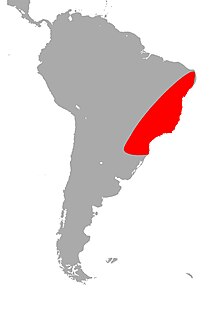| Micrurus corallinus | |
|---|---|

| |
| Conservation status | |
 Least Concern (IUCN 3.1) | |
| Scientific classification | |
| Domain: | Eukaryota |
| Kingdom: | Animalia |
| Phylum: | Chordata |
| Class: | Reptilia |
| Order: | Squamata |
| Suborder: | Serpentes |
| Family: | Elapidae |
| Genus: | Micrurus |
| Species: | M. corallinus |
| Binomial name | |
| Micrurus corallinus (Merrem, 1820) | |

| |
| Synonyms | |
|
Elaps corallinus | |
Micrurus corallinus is a species of highly venomous elapid snake native to South America (Brazil, Argentina and Paraguay). There are no recognized subspecies.
Common names
Common names of this species include painted coral snake, cobra coral pintada, mboi-chumbe, vibora de coral, boicora, bocora, coral-verdadeira, ibiboboca, and mboi-yvyvovo.
Description and Behavior
The painted coral snake is a medium-sized tri-colored snake which can grow to 98 cm (39 in), but most are closer to 65–85 cm (26–33 in). It is a snake with nocturnal habits found on the coastlines, through leaves, on top of logs and stones, its diet is based on lizards, other snakes (including coluibrids), amphisbenids and gymnophils.
The head color is black with a white or yellow back band, which narrows strongly in a dorsal shape, the bodies have wide red rings that are separated by a series of 15–27 (usually 17–21) by wide and narrow black rings and with white borders. The tail has 3 to 8 alternating black and yellow rings. They have a slim body, with a moderately short tail in the case of males and very short in the case of females, the head is round, small and a little distant from the neck. The eyes are slightly small with round pupils. It has smooth and shiny dorsal scales, without apical punctuation. The supra-anal keels are absent in males.
Distribution and habitat
Its range includes South America in Brazil (Rio Grande do Sul, Rio Grande do Norte, Bahia, Santa Catarina, Espírito Santo), northeastern Argentina (Misiones), and Paraguay. It is mainly found in the Amazon basin in tropical deciduous and evergreen forest at elevations ranging from sea level to 500 m.
Reproduction
Reproduction is oviparous, laying up to 15 eggs.
Venom
It is not aggressive towards humans, the group of coral snakes represents only 1% of accidents in Central and South America, however the venom produced by them is highly potent, with neurotoxic action, causing neuromuscular block, which results in death from respiratory arrest, resulting from paralysis of the respiratory muscles. The LD50 for a 5–27 grams mouse is 0,007 mg. 0.2 mg/kg (intramuscular injection), 0.09 mg/kg (intraperitoneal) and 0.04 mg/kg (intravenous).
The venom of this species is compound of the three-finger toxin families, Phospholipase A2, L-amino acid oxidase, True venom lectin, SVMP (snake venom metalloproteinase), Kunitz-type inhibitor (Venom Kunitz-type), NGF (NGF -beta) and Waprin. The amount of venom extracted from this species is 3 mg. The venom of this species has presynaptic activity. M. corallinus has alpha-neurotoxins with pre-synaptic activity that causes a high and spontaneous release of acetylcholine associated with the postsynaptic block of the electrical transmission between the nerve and the muscle.
References
- ^ Cacciali, P.; Carreira, S.; Fitzgerald, L.; Giraudo, A.; Kacoliris, F.; Montero, R.; Scott, N. (2019). "Micrurus corallinus". IUCN Red List of Threatened Species. 2019: e.T56040806A56040867. doi:10.2305/IUCN.UK.2019-3.RLTS.T56040806A56040867.en. Retrieved 9 February 2022.
- ^ "Living Hazards Database (LHD) – Search by Scientific Name" (PDF). Living Hazards Database (LHD).
- ^ Micrurus corallinus at the Reptarium.cz Reptile Database. Accessed 9 February 2022.
- "Micrurus Corallinus - Coral e Peçonhenta | Animais - Cultura Mix". animais.culturamix.com. Retrieved 2020-09-30.
- Serapicos, Eliana de Oliveira; Merusse, José Luiz Bernardino (December 2002). "Análise comparativa entre tipos de alimentação de Micrurus corallinus (Serpentes, Elapidae) em cativeiro". Iheringia. Série Zoologia (in Portuguese). 92 (4): 99–103. doi:10.1590/S0073-47212002000400012.
- "WCH Clinical Toxinology Resources". www.toxinology.com. Retrieved 2020-10-17.
- Tanaka, Gabriela D.; Furtado, Maria de Fátima D.; Portaro, Fernanda C. V.; Sant'Anna, Osvaldo Augusto; Tambourgi, Denise V. (2010). "Diversity of Micrurus snake species related to their venom toxic effects and the prospective of antivenom neutralization". PLOS Neglected Tropical Diseases. 4 (3): e622 . doi:10.1371/journal.pntd.0000622. PMC 2834742. PMID 20231886.
- Sant’Ana Malaque, Ceila Maria; Gutiérrez, José María (2016), Brent, Jeffrey; Burkhart, Keith; Dargan, Paul; Hatten, Benjamin (eds.), "Snakebite Envenomation in Central and South America", Critical Care Toxicology, Cham: Springer International Publishing, pp. 1–22, doi:10.1007/978-3-319-20790-2_146-1, ISBN 978-3-319-20790-2, retrieved 2020-09-30
- "Micrurus corallinus ~ VenomZone page". venomzone.expasy.org. Retrieved 2020-10-15.
- de Castro, Karen Larissa Pereira; Lopes-de-Souza, Letícia; de Oliveira, Daysiane; Machado-de-Ávila, Ricardo Andrez; Paiva, Ana Luiza Bittencourt; de Freitas, Cláudio F.; Ho, Paulo Lee; Chávez-Olórtegui, Carlos; Guerra-Duarte, Clara (2019). "A Combined Strategy to Improve the Development of a Coral Antivenom Against Micrurus spp". Frontiers in Immunology. 10: 2422. doi:10.3389/fimmu.2019.02422. PMC 6816313. PMID 31695693.
- Seligman, Renato (1993). "Acidente por Micrurus frontalis: primeiro relato de envenenamento elapídico no Rio Grande do Sul" (PDF). Memórias do Instituto de Butantan (in Portuguese). 55 (2): 65–68.
- Silva, Alvaro Rossan de Brandão Prieto da (2002). Clonagem, expressão e estudo de alguns cDNAs codificando proteínas estruturalmente relacionadas às alfa neurotoxinas da glândula de veneno da cobra coral Micrurus corallinus (Serpentes, Elapidae) (PDF) (Doctoral thesis). Universidade de São Paulo. doi:10.11606/T.46.2002.tde-17072002-213926.
External links
- [REDACTED] Media related to Micrurus corallinus at Wikimedia Commons
| Taxon identifiers | |
|---|---|
| Micrurus corallinus | |
| Elaps corallinus | |